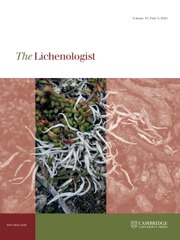No CrossRef data available.
Article contents
Phylogenetic insight into the Lecidea atrobrunnea complex – evidence of narrow geographic endemics and the pressing need for integrative taxonomic revisions
Published online by Cambridge University Press: 22 September 2023
Abstract
Species of lichen-forming fungi (LFF) display an array of geographical distribution patterns. Among the broadly distributed lichen-forming fungal species, the degree of reproductive isolation and genetic substructure among populations varies widely, in some cases masking unrecognized diversity or meaningful biogeographical patterns. Lecidea atrobrunnea (Raymond ex Lam. & DC.) Schaer. s. lat. (Lecideaceae) is a widespread species complex that has been studied for over two centuries since its initial description. The diversity of the L. atrobrunnea group is highest in western North America, where a dizzying array of morphologies and chemistry can occur at local scales. Here we investigate whether the assumed cosmopolitan distribution of L. atrobrunnea s. lat. is an artifact of taxonomic limitations and masks biogeographical patterns in this species complex. To address these questions, we compiled sequence data from the standard fungal barcoding marker (ITS) for over 100 specimens within this complex, in addition to genome-scale data from a subset of these representing over 1600 single-copy nuclear genes spanning over 3 Mb of the genome. Our study corroborates the perspective that the morphologically and chemically variable Lecidea atrobrunnea group reflects a complex of distinct species-level lineages, with 42–83 candidate species inferred from the ITS region and high levels of diversity inferred from a subset of specimens using genome-scale data. However, both phenotype- and molecular-based species boundaries remained unsettled, with the most common nominal taxa recovered as highly polyphyletic and with conflict among different molecular species delimitation approaches. Our study also highlights the potential for geographically restricted species, with fascinating biogeographical patterns, challenging, in part, the assumed cosmopolitan distribution of L. atrobrunnea s. lat. This study provides valuable direction for future research that will be crucial in understanding diversification and establishing a robust taxonomy for this well-known species complex.
Keywords
Information
- Type
- Standard Paper
- Information
- The Lichenologist , Volume 55 , Special Issue 5: Special issue dedicated to Professor Pier Luigi Nimis , September 2023 , pp. 253 - 264
- Copyright
- Copyright © The Author(s), 2023. Published by Cambridge University Press on behalf of the British Lichen Society


